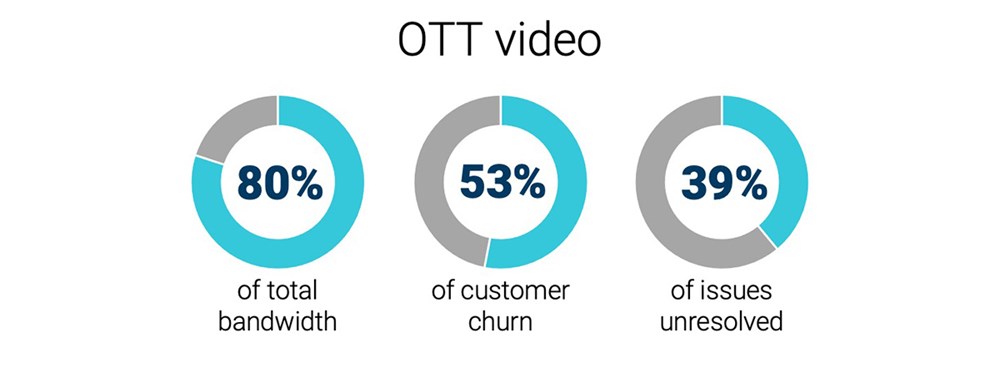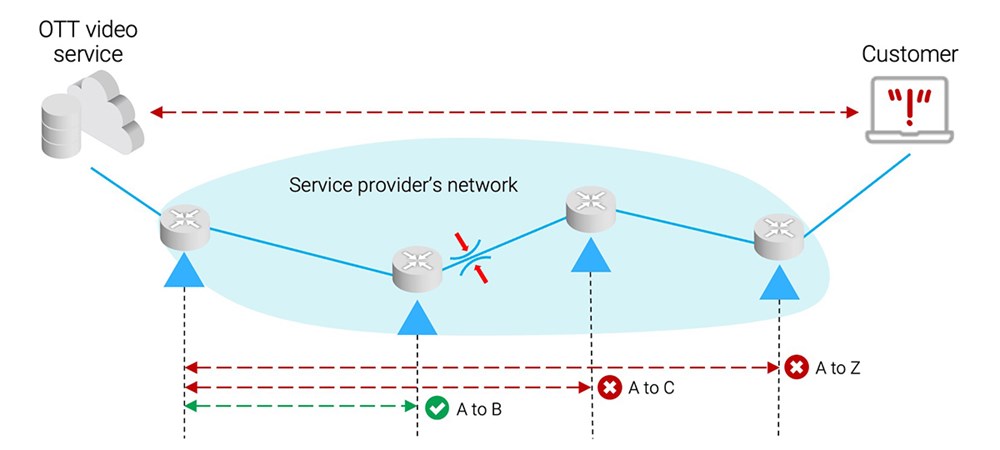Is over-the-top video a threat or an opportunity for service providers?
As OTT video services continue to grow in popularity, they bring a double-edged sword—something that is equally true for both wireline communication service providers (CSPs) and mobile network operators (MNOs). On the one hand, these services drive the desire—and even the willingness to pay more—for higher bandwidth, better performance data plans. The simple fact that OTT video services are expected to make up nearly 75% of all mobile network traffic by 20251, serves as proof. On the other hand, poor video QoE can be devastating to an operator’s brand. Video QoE has been shown to account for as much as 53% of net promoter score (NPS)2, which serves as an excellent proxy for customer churn—the lower the NPS, the greater the churn. Without the right tools and visibility, OTT video transport issues will quickly damage your ability to attract and retain premium customers. In fact, 39% of all OTT video issues currently go unresolved, despite being the leading cause of network churn3.

Of course, the challenge with OTT services is that they typically originate and terminate outside the service provider’s network and are encrypted—making it challenging to monitor adequately with traditional methods. For the service provider, the most important thing is to be able to quickly identify and fix any issues in the transport of OTT services across their network—and this means rapidly detecting degradations in an OTT service and then segmenting the service monitoring to pinpoint the exact location. But how can this be done when the service is encrypted, and foreign to your network?
Ideally, you would measure and correlate the customer QoE with the network QoS to deliver actionable insight that speeds up repair. However, the nature of an OTT service—encrypted and foreign—makes this impractical, so an alternative method is needed.
For OTT video services, the biggest impact on customer QoE comes from buffering—the amount of video already delivered to the viewing device and waiting to be played out. We are all quite familiar with what happens when the play indicator, at the bottom of the video, overtakes the grey shaded part—the video freezes and we wait…
For OTT video QoS, we need to measure things like latency, packet loss and jitter—the same network KPIs we would measure for any service. The challenge here is that you can’t directly measure the service since it originates and terminates outside of your network, and it’s encrypted.
What’s needed is a reasonable proxy for an OTT service that replicates the transport of the service within your network. And, since the network is now virtual and dynamic, the monitoring of these proxy services needs to be, as well. For network QoS, we can leverage active assurance techniques, like RFC-6349, to measure the TCP delivery performance of the proxy service. And by selecting the appropriate endpoint, the QoS testing can follow the same path as an OTT service.

For customer QoE, this can be derived by continuously analyzing the state of a video playout buffer—and since we are focusing on OTT transport performance, there is no need to actually render the video. We only need to pull video data from the buffer at an appropriate rate, according to the specific video resolution under test.
Additionally, since these probes are orchestratable, they can be dynamically positioned to pinpoint the exact location of the fault along the end-to-end service path, once an issue has been detected. And by correlating QoE metrics with QoS KPIs, the exact cause of the service impact can be automatically identified, and the appropriate operations team notified. Finally, since the transport path can now be monitored from ingress to egress, it is now possible to see whether an issue originates inside your network or elsewhere—for example, in the customer’s device or the video providers domain.
Threat or opportunity?
So, back to the question: is over-the-top video a threat or an opportunity for mobile network operators? We’ve seen that OTT video is quickly becoming the dominant source of traffic in the service provider’s network—and it’s not just consumers. With more people working from home and business travel severely restricted, enterprises are becoming increasingly dependent on OTT video conferencing services. Poor video QoE for either of these groups could spell disaster for a CSP. Poor QoE drives up customer acquisition costs, increases reliance on retention giveaways and discourages customers from signing up for premium service plans. All three of these are extremely costly and directly impact the operator’s ability to invest in next-generation services and network infrastructure, such as 5G core.
However, OTT video “done-right” can provide significant differentiation in a highly competitive, thin-margin business. For example, mobile network customers, both individual and enterprise, expect 5G to provide an exceptional QoE and the MNOs that deliver on that can expect greater loyalty and a willingness to move up to premium service offerings.
Recently, there has been significant discussion around the move by service providers to become video content aggregators. The concept of “streaming video fatigue” has been attributed to customers who are overwhelmed with the number of video content providers and what they offer. For example, according to a recent Omdia report , on average, “OTT households” subscribe to 1.7 different video services, and simply can’t keep up with the changing landscape. To address this, service providers are exploring the option of offering specific OTT video content bundles, target at key viewer preferences—and while this holds the possibility of increasing customer satisfaction, ARPU and attracting more customers, once again, a poor quality of experience would easily undo this gain.
OTT video services are a key part of any CSP’s offering and essential for success. CSPs must have complete visibility into the performance of their transport network and the impact it has on these services to identify and resolve them quickly. To find out how EXFO can help you effectively manage your OTT video opportunities, visit us at Automated service assurance solutions.
1 Ericsson 2019 Mobility Report
2 Portevo 2020
3 EXFO OTT Video customer survey – September 2020
4 Omidia - 2021 Trends to Watch: Telco Video Operator Strategies | October 2020




